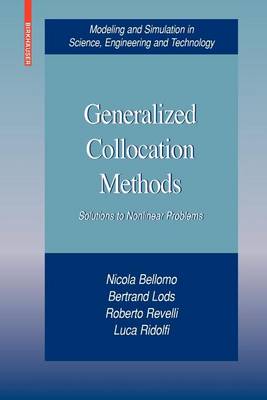Modeling and Simulation in Science, Engineering and Technology
5 total works
This book develops new mathematical methods and tools to model living systems. The material it presents can be used in such real-world applications as immunology, transportation engineering, and economics. The first part of the book deals with deriving general evolution equations that can be customized to particular systems of interest in the applied sciences. The second part of the book deals with various models and applications. The book will be a valuable resource to all involved in modeling complex social systems and living matter in general.
A Quest Towards a Mathematical Theory of Living Systems
by Nicola Bellomo, Abdelghani Bellouquid, Livio Gibelli, and Nisrine Outada
The first chapter discusses the main features of living systems and outlines a strategy for their modeling. The following chapters then explore some of the methods needed to potentially achieve this in practice. Chapter Two provides a brief introduction to the mathematical kinetic theory of classical particles, with special emphasis on the Boltzmann equation; the Enskog equation, mean field models, and Monte Carlo methods are also briefly covered. Chapter Three uses concepts from evolutionary game theory to derive mathematical structures that are able to capture the complexity features of interactions within living systems. The book then shifts to exploring the relevant applications of these methods that can potentially be used to derive specific, usable models. The modeling of social systems in various contexts is the subject of Chapter Five, and an overview of modeling crowd dynamics is given in Chapter Six, demonstrating how this approach can be used to model the dynamics of multicellular systems. The final chapter considers some additional applications before presenting an overview of open problems. The authors then offer their own speculations on the conceptual paths that may lead to a mathematical theory of living systems hoping to motivate future research activity in the field.
A truly unique contribution to the existing literature, A Quest Toward a Mathematical Theory of Living Systems is an important book that will no doubt have a significant influence on the future directions of the field. It will be of interest to mathematical biologists, systems biologists, biophysicists, and other researchers working on understanding the complexities of living systems.
A Survey of Models for Tumor-Immune System Dynamics
by John A Adam and Nicola Bellomo
Mathematical Modeling of Complex Biological Systems
by Abdelghani Bellouquid and Marcello Delitala
This book describes the evolution of several socio-biological systems using mathematical kinetic theory. Specifically, it deals with modeling and simulations of biological systems whose dynamics follow the rules of mechanics as well as rules governed by their own ability to organize movement and biological functions. It proposes a new biological model focused on the analysis of competition between cells of an aggressive host and cells of a corresponding immune system. Proposed models are related to the generalized Boltzmann equation. The book may be used for advanced graduate courses and seminars in biological systems modeling.
Generalized Collocation Methods
by Nicola Bellomo, Bertrand Lods, and Roberto Revelli
Analysis of nonlinear models and problems is crucial in the application of mathematics to real-world problems. This book approaches this important topic by focusing on collocation methods for solving nonlinear evolution equations and applying them to a variety of mathematical problems. These include wave motion models, hydrodynamic models of vehicular traffic flow, convection-diffusion models, reaction-diffusion models, and population dynamics models. The book may be used as a textbook for graduate courses on collocation methods, nonlinear modeling, and nonlinear differential equations. Examples and exercises are included in every chapter.



